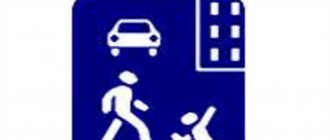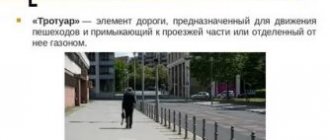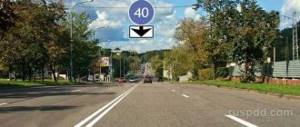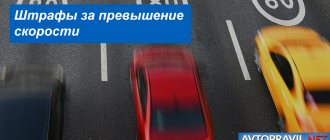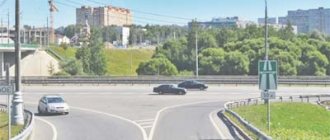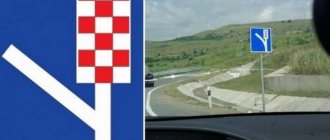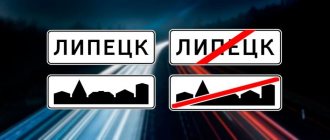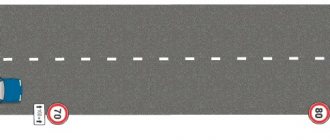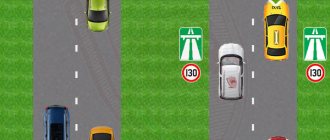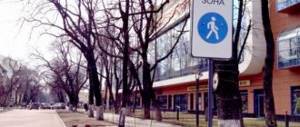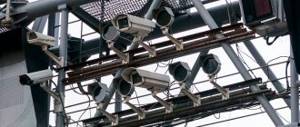A traffic sign is a graphic symbol, an image inscribed in a geometric figure. Each pattern and color has its own meaning, indicates the direction to the road user, and brings to his attention useful information on this section of the road. Signs are made to specific standards and have the same meaning all over the world.
Traffic signs play a very important role in ensuring road safety. There are symbols warning the driver about a dangerous turn or narrowing of the road, prohibiting overtaking in some places, recommending to reduce speed, and informing which settlement the car has passed through. All this helps to navigate the terrain in unfamiliar cities and prevents chaos on the roads.
The latest changes to the standards for the appearance of road signs and markings came into force on January 1, 2006. They have been updated in accordance with UN requirements and European canons. Before we dwell in detail on the meaning of the “Recommended Speed” sign, let’s consider what road signs generally exist.
Types of signs
There are a total of eight types of graphic symbols, each performing its own important function:
- Warning signs alert the driver to dangerous situations on the road. The sign is inscribed in black in a white triangle with a red outline.
- Priority signs show the order of traffic on turns, on narrow roads, and on circular markings.
- Prohibitory symbols are placed on a white circle with a red outline; the design is black. The role of such symbols is to limit or completely prohibit traffic in a certain place.
- Information signs are a blue rectangle; they tell traffic participants about the characteristic features of road markings, the location of traffic lanes, and the availability of gas stations or vehicle servicing.
- Information and guidance symbols show the direction of travel.
- Additional plates (white rectangles, black border and inscription) are used only in conjunction with the main symbols.
- Signs of special regulations.
Road markings 2021 and its characteristics
(according to GOST R 51256-99 and GOST 23457-86)
Markings on Russian roads are applied in accordance with standards, using water-based paint with the addition of polymer resins, and sometimes reflective particles.
The markings can be horizontal or vertical, and they are represented by various lines, arrows, and pictograms on the asphalt. Its color can be:
- white (permanent marking);
- yellow;
- orange (temporary markings), which are applied when carrying out repair work or changing the travel pattern.
If there are both white and orange markings on the road, then you need to follow the orange one.
Vertical markings mark vertical objects on the road in order to attract drivers' attention to them. You can see it on bridge supports, bollards, fenders and other objects in the form of a series of stripes of white and black.
You can learn more about road markings and their symbols here:
- Horizontal marking
- Vertical marking
In 2021, new signs appeared - environmental ones, represented by plates 5.35-5.38. They can be supplemented with plate 8.23 “Photo and video recording”.
Also in April 2021, new road markings 1.26 “Waffle Iron” were introduced.
We invite you to watch a video about road markings and signs for 2019.
Useful information on traffic rules:
- Traffic rules, traffic rules of Ukraine
- Traffic rules, traffic rules of the Republic of Belarus NEW!
- Traffic rules for kids (in pictures)
- Traffic rules with humor
- Traffic rules on video (for children)
- Traffic rules on posters (USSR)
- History of traffic rules NEW!
- Traffic rules in the countries of the world NEW!
- Bribes to the traffic police - complete statistics on bribery of traffic police officers
- Alcohol test - online test for alcohol content in the body
- Inspection - how to proceed correctly during the inspection
- A reminder about alcohol - it's useful to have in your car
- Code of Administrative Offenses of the Russian Federation - what punishment follows for each violation
Interesting on the topic
Related news:
Car prices are expected to soar in Russia
How to find out the paint color of a car by VIN code
In some cases, they want to exempt drivers from paying fines
Road signs and markings 2019
Recommended speed sign
This symbol stands apart from other road signs that drivers must follow strictly. It is a blue square with a white stripe along the edge. There are numbers written on it indicating the speed in kilometers per hour. For example, if the sign Recommended speed is 50, then the driver can reduce the speed to this level in this place. But this speed is not a prerequisite for a participant in the movement.
The decision to reduce the speed to this level must be made by the driver himself, at his own discretion. Hence the name: the “Recommended Speed” sign. Let's consider when such a sign is placed on the roadway.
Sign on traffic rules tickets
You are driving a truck with a permissible maximum weight of no more than 3.5 tons. In which direction are you allowed to move further?
More details
Which of the following signs are used to indicate the number assigned to the road (route)?
More details
What does this road sign with a yellow background inform you about?
More details
You are driving a truck with a permissible maximum weight of more than 3.5 tons. In which direction are you allowed to continue driving?
More details
Which of the following signs are used to indicate the number assigned to the road (route)?
More details
What does this road sign with a yellow background inform you about?
More details
Traffic information signs belong to the category of signs whose task is to inform road users about the location of settlements and other areas and the presence of various traffic modes on certain sections of the road. Information signs are signs that indicate the recommended speed, general maximum speed limits, traffic patterns, etc. Also, signs indicating preliminary directions, route numbers and detour directions are also informational. Simply put, in this category of signs there are no prohibitions or regulations, but only information about the further section of the road and the traffic regime on it. Information signs are installed directly in front of the area about which they provide information. All the images on these signs are easy to understand and you won’t have to spend a lot of effort to remember their designations, since everything is quite simple and logical.
Use of the sign
Along many kilometers of roads around the world there are a huge number of road symbols. Drivers, gaining knowledge in driving courses, study their meaning in detail. Some occur quite often and people remember them well, others are rare, but thanks to the drawing on the plate, its meaning is clear. But the “Recommended speed” sign has only two numbers and not every driver remembers the meaning and use of such symbols.
Many people confuse this sign with a restrictive symbol, which obliges the driver to forcibly reduce the speed to the desired mark on the speedometer. It is actually quite simple to distinguish between symbols having such different meanings. The “Recommended speed” road sign has white numbers on a blue background, and the “speed limit” road sign has red numbers on a white background. The blue sign is square, the white sign is round.
When the speed limit sign goes away
Every driver has encountered speed limit signs at least once outside the city. They are not supplemented with various signs, so many do not understand at what point their coverage area ends.
As a rule, such signs are installed in front of pedestrian crossings. Or, in the spring, road work was carried out, a speed limit sign was installed, and when the repairs were completed, they simply forgot to remove it. Traffic police officers like to control these areas, and they often go out for inspections. Therefore, every driver must understand how to determine the coverage area of signs so as not to receive a fine.
Information signs . In the Traffic Rules you can find clarification of the areas of validity of various restrictions. In most cases, the zone is determined using the cancellation sign 3.25. It is presented in the form of a white circle, which is crossed out by five thin lines diagonally. If a driver meets him on the road, this means that all signs that were there before are canceled. Afterwards you need to follow the traffic rules that are accepted for public roads.
Sometimes a restriction sign may be installed along with a sign indicating the extent of the coverage area. For example, there is a sign “40”, where the bad road begins, and under it there is a sign “3 km”. This means that at a speed of 40 km/h you need to drive for 3 km.
In addition, the beginning of a populated area can serve as a limiter for the sign’s coverage area. When the driver sees sign 5.23, which shows the name of a city or town on a white background, he can continue driving at a speed of no more than 60 km/h.
Crossroads . Another element that cancels the effect of a sign is an intersection. However, here you need to understand the designation of the term. The Traffic Rules state that an intersection is the point of intersection, junction or branching of roads that are at the same level. This does not include leaving the adjacent territory. Any intersection is indicated by a corresponding sign indicating priority.
There are 2 types of uncontrolled intersections on roads - equivalent and unequal. The first one can very often be found outside the city. There are no traffic lights or priorities in these areas. To drive through such an intersection, you need to remember the “interference on the right” rule.
An unequal intersection is regulated by a special priority sign indicating the main road. For example, sign 2.1, which is a yellow diamond with a white border, or signs 2.3.1-2.3.7 - a triangle with black stripes that show the direction of the road. The thick strip is the main road, and the thin strip is the secondary road. All of the above intersections cancel the coverage area of the speed limit sign.
Exit and pedestrian crossing . The adjacent road is not an intersection. Such areas are not marked with special signs, and the driver may not even notice them. However, at the exit itself there is always a sign 2.4 “Give way”. If a similar exit occurs after a speed limit sign, it cannot be regarded as an intersection, so the speed limit zone continues to be in effect.
Even pedestrian crossings do not cancel the action. As a rule, a “40” sign is installed in front of them. When a driver passes a crossing, and there is no sign behind it that would cancel the restrictions, you need to continue driving at that speed until the intersection or populated area.
Bottom line . Speed limit signs can be found very often. However, not all drivers know when they can start driving at normal speed and where their coverage area ends. You need to pay attention to certain signs, the presence of intersections and populated areas.
Reasons for installing such a sign
This sign is used as good advice to drivers to protect them from erroneous actions. For example, before a steep descent there may be a “Recommended Speed” sign of 40. Usually an additional sign is placed at the top or bottom explaining the reason for setting such a number. In our case, it will be a sign with a drawn slope and the inscription 40 degrees. This means that the descent is steep, and it would be advisable for the driver to reduce speed.
Let's give another example. The number 50 is written on the blue square, and underneath there is an additional cloud with rain on a white background. This means that the road is wet after precipitation and it is advisable to drive at a speed of 50 km. Above the entrance to the highway there are numbers on top indicating which lanes the recommended speed is.
Traffic in a populated area with blue background
The “settled area” sign, blue 5.25, means that the rules adopted in populated areas regarding speed limits in this area do not apply. It is duplicated by the same sign 5.26, only crossed out with a red line. According to traffic rules, if a motorist passes the name of a settlement on a blue background, the speed does not need to be reduced, since the speed limit is 90 km per hour. Be sure to pay attention to the signs that may appear after it - there may be a speed limit.
Fines
On the Internet, people often describe cases where traffic police officers tried to file claims against a driver for failure to comply with traffic signs. People who did not know the rules and the meaning of the symbolism of road drawings were fined. Others, who understand the meaning of the graphic and color symbols along the road, filed complaints and were acquitted.
All drivers should remember that the speed recommended by the sign is not mandatory. If the driver believes that he can handle driving in a dangerous place, then he can continue driving the vehicle as usual. There is no penalty for failure to comply with the recommendations of this sign.
